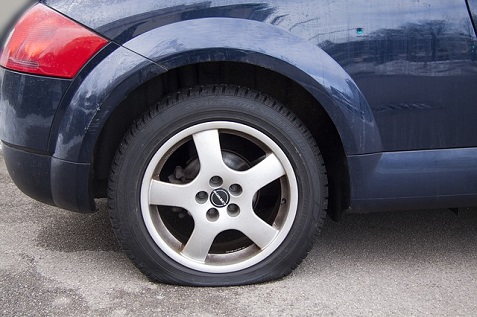How to Safely Change a Flat Tire

Everyone has a flat tire at some point in their life so it is important to know how to change a tire on a car safely. The car manufacturers put plenty of work into providing car owners with all the tools necessary to change a tire but these tools must be used properly. In this step-by-step guide, we will outline some safe procedures for you to follow when you change a tire. You may want to print it out and keep it in your glove box. For all you visual learners out there, there are a number of videos on Youtube that can help you out via your smartphone also. Note: The auto technicians at Ford Dodge Toyota (http://www.fdford.com) want to remind you spare tire is not meant for extended travel, so only use your spare tire to drive to the nearest tire shop or home. Most manufacturers rate them for some 40-50 miles of travel.
Step-by-step guide for safely changing a flat tire:
1. If you sense a tire has gone flat, pull off to the side of the road onto a level surface.
2. Locate and put on your emergency flashers.
3. Have all passengers exit the vehicle and have them stand well away from the car and moving traffic.
4. Put the car in park and set the emergency brake so it can’t roll. (If you have a manual transmission, put the car in first gear).
5. Since you are going to be jacking your car up in the air, consider placing something solid (a rock or log, for example) behind one of the undamaged tires to prevent the vehicle from rolling.
6. Locate your spare tire and tools. These items are typically in the trunk. In an SUV, they may be in the back or mounted underside. If you can’t find them, consult your owner’s manual.
7. If the lug nuts that hold your tire to the hub aren’t exposed and visible, you’ll need to remove the hubcap. This is usually done by using a tire iron and placing the flat bladed end under the hubcap and “popping” it free.
8. Lug nuts need to be loosened a turn or so using the tire tool while the wheel is on the ground (Very important!). Sometimes these are on tightly so they can be very difficult to crack loose. Remember you are turning them counterclockwise. You may want to use your body weight on the tool to get them to turn.
9. You can now jack your car up in the air. Slide the jack under the car and position it on a secure spot on the frame (Very important!). Your owner’s manual can assist you in finding the best spot under the frame of your car.
10. Then slowly turn the handle on the jack until the tire lifts off the ground.
11. Then you can completely remove the lug nuts from the flat tire and place them somewhere for safe keeping.
12. Remove the tire. It may be heavy, so do this slowly and with care. If the tire is stuck on the hub, give it a kick with your foot, but be careful and don’t lose your balance.
13. Once the flat tire is removed from the hub, lift the spare tire onto the screw studs, lining up the screws with the holes in the tire. Then screw on the lug nuts until they are hand tight.
14. Then lower the car with the jack just enough so that the tire doesn’t spin.
15. Using your tire tool, tighten the lug nuts in an alternating pattern. Turn them to the right to tighten and put some strength into it! You want those lug nuts on really tight.
16. Lower the vehicle all the way and remove the jack.
17. Reinstall the hubcap, if you have one.
18. Put everything back in your car and drive carefully to the nearest tire shop or head home.
For additional information and details for changing a flat tire, reference the owner’s manual for your car. As we mentioned before, there are plenty of Youtube videos that you may find helpful also.
Article Source: Ford Dodge Ford and Toyota







